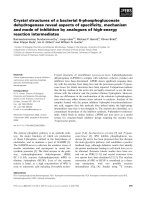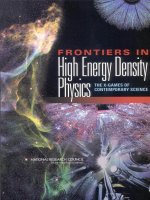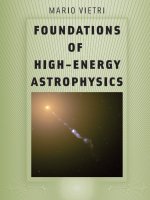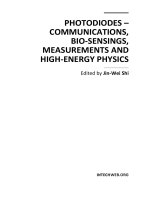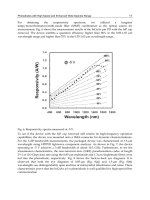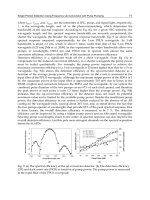High energy physics
Bạn đang xem bản rút gọn của tài liệu. Xem và tải ngay bản đầy đủ của tài liệu tại đây (6.02 MB, 42 trang )
High Energy Physics
Text: D. Griffiths: Introduction to Elementary Particles
John Wily & Sons (1987)
Reference:
C H Oh
F. Halzen and A.D. Martin: Quarks & Leptons John-Wiley & Sons
(1984)
D.H. Perkins: Introduction to High Energy Physics
(4th Edition) Cambridge University Press (2000)
Physics Department
Fayyazuddin & Riazuddin: A Modern Introduction to Particle Physics
(2nd edition) World Scientific Publishing
(2000)
General Reading:
(1) Brian Greene: The Elegant Universe (1999), QC794.6 Str. Gr
(2) M Veltman: Facts and Mysteries in Elementary Particle Physics (2003)
(3) Leo Lederman: The God Particle:If the Universe is the Answer, What is the
question, Boston: Houghton Mifflin (1993), QC793.Bos.L
Websites:
Update of the Particle Listings available on the Web
PDG Berkeley website: />The Berkeley website gives access to MIRROR sites in:
Brazil, CERN, Italy, Japan, Russia, and the United Kingdom.
Also see the Particle Adventure at:
(Leo Lederman)
/>
Contents
§1
Introduction
§1.1 Introduction
§1.2 Particles
§1.3 Basic Interactions (forces)
§1.4 Theoretical Framework
§1.4.1 Quantum Field Theories
§1.4.2 Feynman Diagram
§1.5
Decays and Conservation Laws
§1.6
Unification
Contents
§2
Relativistic Kinematics
§2.1 Lorentz Transformations
§2.2 4-Vectors and Tensors
§2.3 Lab and CM Frames. Conserved Quantities
and Invariants
§2.4 Elastic and Inelastic Collisions
§2.5 Examples
§3
Symmetries
Contents
§3.1 Symmetries, Groups, and Conservation Laws
§3.2 Review of Angular Momentum. ClebschGordan Coefficients
§3.3 Isospin and Flavour Symmetries
§3.4 Parity
§3.5 Charge Conjugation
§3.6 CP Violation
§3.7 Time Reversal
Contents
§4 Decays and Scattering
§4.1 Lifetimes and Cross Sections
§4.2 The Fermi Golden Rule
§4.2.1 Golden Rule for Decays
§4.2.2 Golden Rule for Scattering
Contents
§5
Quantum Electrodynamics
§5.1
Relativistic Equations of Motion. The Dirac
Equation
§6
§5.2
Solutions to The Dirac Equation
§5.3
Bilinear Covariants
§5.4
The Photon
§5.5
The Feynman Rules for QED
§5.6
Examples
§5.7
Casimir’s Trick and The Trace Theorems
§5.8
Cross Sections
Introduction to Gauge Theories
1.1 Introduction
Elementary Particles = Basic constituents of matter Not ⇒
Particles are pointlike
To break matter into its smallest pieces, need high energy
∴ Elementary particle physics = high energy physics
Present energy achieved ≈ 1 TeV ≈ 1000 GeV ≈1012 eV (Fermilab)
LHC (2007) proton beams 7 TeV + 7 TeV = 14 TeV
Theoretical discussion on the unification of basic forces has
reached the Planck energy scale
1/ 2
hc
−5
19
28
=
10
gm
=
10
GeV
=
10
eV
÷
GN
Close to the energy scale at which the universe is created.
1.2 Particles
Leptons: Particles do not participate
in strong interaction.
Q
e
ve
µ
vµ
τ
vτ
-1
0
-1
0
-1
0
Le
Lµ
1
1
0
0
0
0
Electron pointlike up to
10-15 cm = 10-2 fm
0
0
1
1
0
0
Lτ
0
0
0
0
1
1
Three generations of quarks
Q
U
D
C
S
T
B
u
2/3
1
0
0
0
0
0
d
-1/3
0
-1
0
0
0
0
c
2/3
0
0
1
0
0
0
s
-1/3
0
0
0
-1
0
0
t
2/3
0
0
0
0
1
0
b
-1/3
0
0
0
0
0
-1
each quark has a nonabelian charge, called colour (source
of strong interaction); there are three different colours.
Baryons and Mesons are bound states of quarks.
e.g.
1.3 Basic Interactions (forces)
Type of force:
Range:
Strength
relative to
strong force at
a distance
10-13 cm
Decay time for
a typical small
mass hadron:
Mediator:
Mass of the
mediator:
Gravitational
infinite
Weak
≤10-16cm
Electro-magnetic
infinite
Strong
≤10-13cm
10-38
10-13
10-2
1
10-10s
10-20s
10-23s
W+,W-,Z0
82 GeV/c2
92 GeV/c2
Photon γ
gluon
0
0
Graviton
0
Theories: Strong interaction
em interaction
Weak interaction
Gravitation
Quantum chromodynamics
QCD
Quantum electrodynamics
QED
Weinberg – Salam
model (Flavour dynamics)
Quantum gravity (?)
Einstein’s general relativity
1.4 Theoretical Framework
1.4.1 Quantum field theories
For particles in interaction, interaction terms are usually derived from a
symmetry principle, called principle of local gauge invariance.
Two types of interaction terms:
ψ ( x )ψ ( x)φ ( x)
ψ ( x )γ µψ ( x) Aµ ( x)
Yukawa
Gauge field theories
In quantum theory, exp (-iS) determines the physics.
1.4.2 Feynman diagram
2. The diagram is symbolic, the lines do not represent particle trajectories.
time
e−
e
−
1st diagram
e
−
e−
e−
e−
e−
e−
2nd diagram
The 2nd diagram contributes less than the first diagram.
5. Each virtual particle (internal line) is represented by the “propagator” (a function describes
the propagation of the virtual particle).The virtual particles are responsible for the description of
force fields through which interacting particles affect on another.
All em phenomena are ultimately reducible to following elementary process (primitive vertex)
1
L = ψγ µ Dµψ − Fµ v F µ v + mψψ
4
1
= ψγ µ ∂ µψ − ieψγ µψ Aµ − Fµ v F µ v + mψψ
4
Interaction vertex
and
ψγ µψ Aµ = j µ Aµ
Fµ v = ∂ µ Av − ∂ v Aµ
All em processes can be described by patching together two or more of the primitive
vertices.
Note: The primitive QED vertex
e
γ
e
by itself does not represent a possible physical process as it violates the conservation
of energy.
Some examples of electromagnetic interaction
time
e−
e−
e−
e−
joining up
two vertices
Particle line running backward in time (as indicated by the arrow) is interpreted as the
corresponding antiparticle running forward.
4.
Pair Annihilation
5.
e + e − → γγ
Compton Scattering e −γ → e −γ
(b)
QCD
Only quarks and gluons involve basic vertices: Quark-gluon vertex
q
g
q
More exactly
q(r )
g (b, r )
q (b)
Gluon vertices
q→q+g
Interaction between two proton
Nucleons (proton or neutron) interact by exchange of π mesons.
e.g.
u
d
u
u
u
u
d
u
u
d
3
2
1
u
u
1
u
d
2
3
First u quark of LH p interacts with d and then propagates to the RH p to become the
u of the RH p and also interacts with the second u of the RH p.
Similarly the first u of RH p interacts with the d and goes to become a u of the LH p
and also interacts with the second u of the LH p.
The coupling constant αs decreases as interaction energy
increases (short-range)
α seff =
αs
ε
ε = dielectric constant
known as asymptotic freedom
αs increases as interaction energy decreases (long range)
known as infrared slavery.
( c ) Weak Interaction
Leptons: primitive vertices connect members of the same generation
Lepton number is separately conserved for each Lepton generation,
that is, Le, Lµ , Lτ separately conserved.
Charged vertex
e.g.
Neutral vertex
Quarks
Flavour not conserved in weak interaction
Charged Vertex.
Semileptonic process
d + vµ → u + µ −
Not observable ∴ quark confinement

